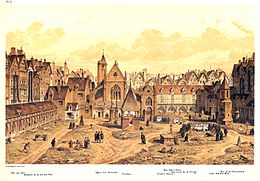- Saints Innocents Cemetery
-
Cimetière des Saints-Innocents 
The Saints Innocents Cemetery, ca.1550. The Church of the Saints Innocents, bordering the Rue Saint-Denis, is in the background.Details Year established 12th century
Removed: 1786
Closed: 1780Country France Location Paris Type Public (not extant) The Saints Innocents Cemetery (French: Cimetière des Saints-Innocents or Cimetière des Innocents) is a defunct cemetery in Paris that was used from the Middle Ages until the late 18th century. It was the oldest and largest cemetery in Paris[1] and had often been used for mass graves. It was closed because of overuse in 1780, and in 1786 the bodies were exhumed and transported to the unused subterranean quarries near Montparnasse known as the Catacombs. The place Joachim-du-Bellay in the Les Halles district now covers the site of the cemetery.
The cemetery took its name (referring to the Biblical Massacre of the Innocents) from the attached church of the Saints Innocents that has now also disappeared.
History
Sources describe the burial ground, then called Champeaux, and associated church in the 12th century.[1] It was located next to the central market (the origin of Les Halles). Under the reign of Philip II the cemetery was enlarged surrounded by a three meter tall wall.
Les Innocents had begun as a cemetery of individual sepulchres, but had become a site for mass graves by then. People were buried together in the same pit (a pit could hold about 1,500 dead at a time); only when it was completely full would another be opened.
In the 14th and 15th century, to relieve the overcrowding of the mass graves, citizens constructed arched structures called charniers along the cemetery walls; bones from the graves were deposited here. Between 1423 and 1424, a fresco of the Danse Macabre was painted at a wall of one of the charniers. It was one of the earliest and best known depictions of this theme. It was destroyed in 1669.[1]
In the 16th century, the prominent Renaissance anatomist, Andreas Vesalius, studied the bones of corpses in the Saints Innocents cemetery.
During the reign of Louis XV, inspectors recorded accounts of the difficulties in conducting business in the area due to the unsanitary conditions of the cemetery, caused by overuse and incomplete decomposition of bodies.
Two edicts by Louis XVI to move the parish cemeteries out of the city were resisted by the church, which profited from burial fees. To reduce the number of burials, the price of burials was increased. After a prolonged period of rain in spring 1780, conditions became untenable. On 4 September 1780, an edict forbade burying corpses in Les Innocents and in all other cemeteries in Paris.
Bodies were exhumed and the bones were moved to the Catacombs in 1786.[2] Many bodies had incompletely decomposed and had turned into fat (margaric acid). During the exhumation, this fat was collected and subsequently turned into candles and soap.[3]
The church was destroyed in 1787 and the cemetery was replaced by a herb and vegetable market. The Fountain of the Nymphs which had been erected in 1549 next to the church was dismantled and rebuilt in the center of the new market. Now known as the "Fountain of Innocents," it still stands on the place Joachim-du-Bellay today.[1]
References
- ^ a b c d Philippe Landru (7 February 2008). "Cimetière des INNOCENTS (disparu)" (in French). http://www.landrucimetieres.fr/spip/spip.php?article275.
- ^ "Paris’ Les Innocents cemetery". http://www.paris-promenades.com/en/site_text/III.htm. Retrieved February 6, 2011.
- ^ "You (posthumously) light up my life". Scientific American blog. 15 April 2011. http://www.scientificamerican.com/blog/post.cfm?id=you-posthumously-light-up-my-life-2011-04-15.
Categories:- Cemeteries in Paris
- History of Paris
Wikimedia Foundation. 2010.


